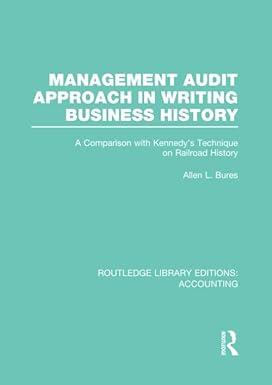Question
See below Enrollment data ; in it you will see historical information on ASU undergraduate enrollment, total credit hour production, and (12-hour, undergraduate) tuition and
See below Enrollment data ; in it you will see historical information on ASU undergraduate enrollment, total credit hour production, and (12-hour, undergraduate) tuition and fees.
| Year | undergrad enrollment | total ASU credit hour production | undergrad tuition and fees |
| 2003 | 3,655 | 101352 | 1442 |
| 2004 | 3,910 | 101868 | 1545 |
| 2005 | 3,940 | 100181 | 1621 |
| 2006 | 3,594 | 92486 | 1667 |
| 2007 | 3,556 | 92123 | 1667 |
| 2008 | 3,903 | 94639 | 1751 |
| 2009 | 4,220 | 101972 | 1867 |
| 2010 | 4,058 | 98137 | 2062 |
| 2011 | 4,134 | 98372 | 2247 |
| 2012 | 4,124 | 93163 | 2472 |
| 2013 | 3,674 | 85292 | 2803 |
| 2014 | 3,202 | 87907 | 3084 |
| 2015 | 2,775 | 91021 | 3355 |
| 2016 | 2,587 | 94077 | 3417 |
| 2017 | 2,638 | 115340 | 3417 |
| 2018 | 2,511 | 137467 | 3663 |
| 2019 | 2,577 | 165057 | 3663 |
| 2020 | 2,553 | 191712 | 3663 |
| 2021 | 2,477 | 173910 | 3663 |
Calculate annual elasticities for both types of quantity variables (i.e., you will have an elasticity of price vs. headcount, and one of price vs. credit hour).You will get an error message in your calculations when the tuition doesn't change (like in 2006-2007), since the elasticity calculation will be trying to divide by zero; just delete those error values in your Excel table so that the cells are blank. The first headcount elasticity will be calculated based on the 2003 and 2004 values of tuition and headcount and should be about 0.978; the first credit hour elasticity will also be based on the 2003 and 2004 values and should be about 0.074 (yes; they are both positive). a. Calculate annual elasticities for both types of quantity variables (i.e. you will have an elasticity of price vs headcount, and one of price vs. credit hour) include whether or not elastic or inelastic and why in the chart. b. Calculate the average annual elasticity for headcount (from 2003-2021)? What would demand in terms of headcount be considered and why? c. Calculate the average annual elasticity for credit hour (from 2003-2021). What would demand in terms of credit hour be considered and why? Is this unexpected? d. Many administrators argue that, to increase revenue to ASUS to cover budget shortfalls, tuition should be raised. Comment on this suggestion, using the evidence youve uncovered regarding tuition, credit hours, and fees with regard to revenue. What does the credit hour elasticity estimate suggest?
Step by Step Solution
There are 3 Steps involved in it
Step: 1

Get Instant Access to Expert-Tailored Solutions
See step-by-step solutions with expert insights and AI powered tools for academic success
Step: 2

Step: 3

Ace Your Homework with AI
Get the answers you need in no time with our AI-driven, step-by-step assistance
Get Started


